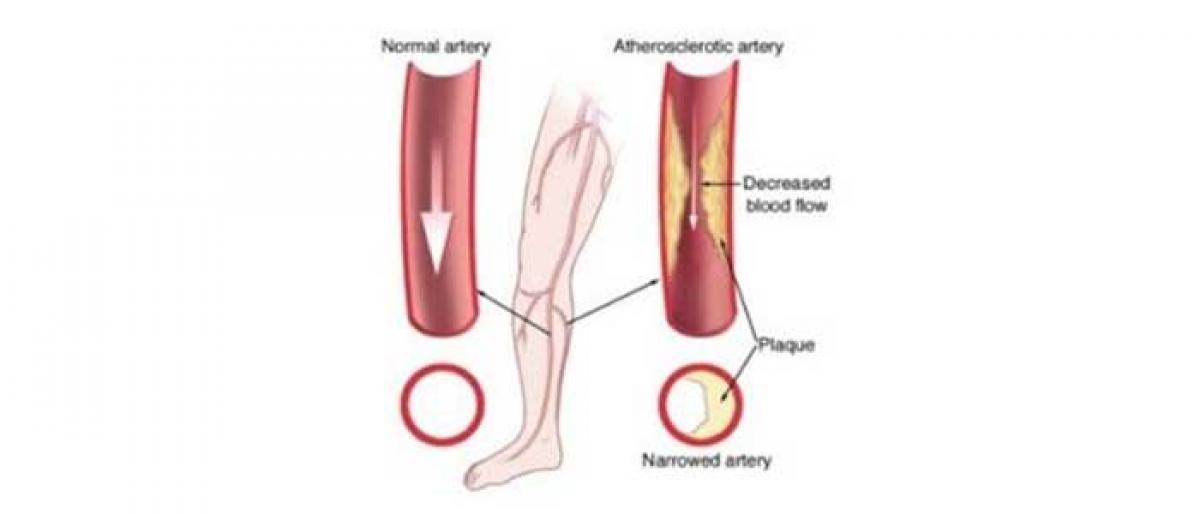Live
- Polling concludes in Maharashtra and Jharkhand Assembly elections
- Chhattisgarh CM Sai briefs HM Amit Shah on progress in Maoist-affected areas
- Bengal PDS case: ED seeks report on medical conditions of jailed former minister
- Siddharth's Romantic Drama Miss You Set to Hit Theaters on November 29
- India’s 1st AI data bank to boost national security launched
- Humbled to receive 'Key to the City of Georgetown', says PM Modi in Guyana
- 11 lakh BPL cards revoked, claims K’taka BJP
- Exit polls results indicated victory of the NDA government in Maharashtra and Jharkhand!
- Deputy CM Bhatti Vikramarka Reviews SC/ST Development Funds Implementation
- AP cabinet approves key decisions, check here
Just In

Vascular disease is as common as cancer and heart disease. Long term mortality from the condition is more than cancer and accounts to upto 40 per cent of deaths. The mortality rate increases in late stages of PAD (Critical limb ischemia) reaching upto 67 per cent; hence it is important for early detection.
Vascular disease is as common as cancer and heart disease. Long term mortality from the condition is more than cancer and accounts to upto 40 per cent of deaths. The mortality rate increases in late stages of PAD (Critical limb ischemia) reaching upto 67 per cent; hence it is important for early detection.
When there is narrowing or blockage of arteries in lower limbs it is called Peripheral Arterial Disease (PAD). It is the first indicator towards the health of vessels in the body. By detecting peripheral arterial disease early, we can prevent various vascular problems.
The whole circulatory system, including heart and brain, are at risk when arteries are blocked and narrowed. PAD is dangerous because these blockages can restrict circulation to the limbs, organs and brain. Without adequate blood flow, vital organs, legs, arms and feet, and your brain, suffer damage. Left untreated, the tissue can become infected or die, called gangrene, and in the worst cases, may result in the need for amputation and even eventual death.
Most common symptom of peripheral artery disease in the lower extremities is a painful muscle cramping, pain or tiredness in the leg (calves) or hip muscles while walking, climbing stairs or exercising. The pain of PAD often goes away when you stop exercising, although this may take a few minutes.
The “crampy” pain (called “intermittent claudication”), when caused by PAD, is the muscles’ way of warning the body that it isn’t receiving enough blood during exercise to meet the increased demand. The most common symptoms of PAD involving the lower extremities. Typically, this pain goes away with rest and returns when you start walking again.
Other symptoms include foot or toe wounds that won’t heal; gangrene, or dead tissue; a marked decrease in the temperature of your lower leg or foot particularly compared to the other leg or to the rest of your body; poor nail growth on the toes or hair growth on the legs and erectile dysfunction, especially in men with diabetes.
Understanding leg pain many people dismiss leg pain as a normal sign of aging. You may think it’s arthritis, sciatica or just “stiffness” from getting older. For an accurate diagnosis, consider the source of your pain. PAD leg pain occurs in the muscles, not the joints. Those with diabetes might confuse PAD pain with a neuropathy, a common diabetic symptom that is a burning or painful discomfort of the feet or thighs. If you’re having any kind of recurring pain, talk to your doctor and describe the pain as accurately as you can.
Physical activity and exercise are important for preventing PAD. Avoid use of tobacco—smoking increases the risk of PAD by six times and it worsens the symptoms of PAD. Control high blood pressure, cholesterol, and diabetes. Supervised exercise training programmes can improve and prolong walking distance in individuals with PAD.
Depending on the type and level of blockage there are treatments available, ranging medications, angioplasty/stenting or surgery as feasible, example short length blockages can be treated with balloon angioplasty/stenting and long length blockages can be better treated with bypass surgery. Sometimes both angioplasty and bypass may be required depending on the complexity.
By: Dr Narendranadh
(The writer is Consultant Vascular and Endovascular Surgery at KIMS Hospitals, Secunderabad.)

© 2024 Hyderabad Media House Limited/The Hans India. All rights reserved. Powered by hocalwire.com







